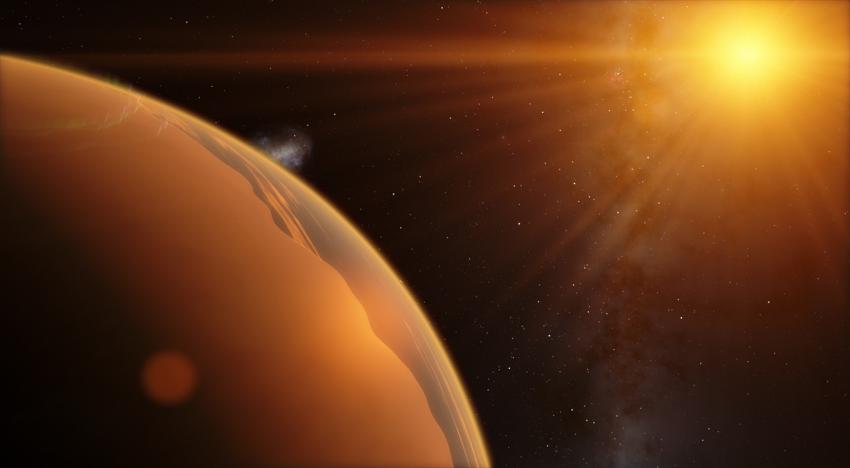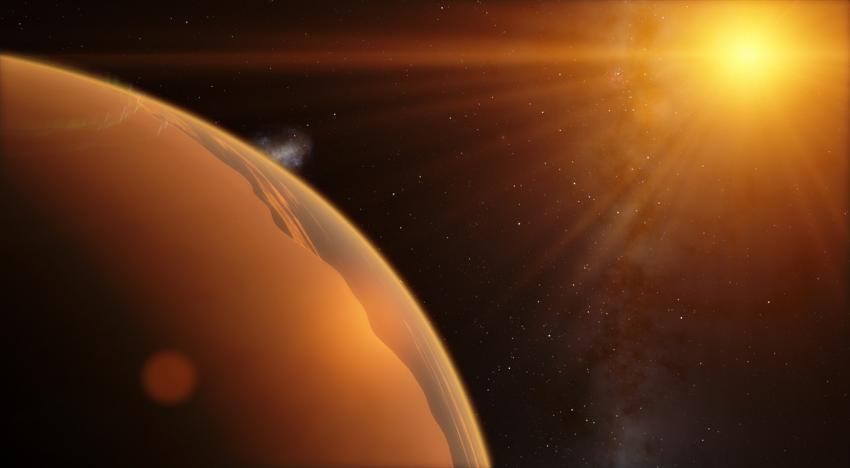Astronomers have shown that water vapour can potentially be detected above impenetrable clouds in the atmospheres of exoplanets, with a cutting-edge technique described in a paper in Monthly Notices of the Royal Astronomical Society. The new method provides another method for detecting the presence of water vapour in an exoplanet’s atmosphere, as well as other chemical species that could be used in future to assess potential signs of life.
By looking at known exoplanets with clouds, the team has demonstrated that the technique in principle can be used to examine the atmospheres of exoplanets that were previously too difficult to characterise, due to clouds that are too dense for enough light to pass through.
Astronomers use light from a planet’s host star to learn what its atmosphere is made of. As the planet passes in front of the star they observe the transmission of the stellar light as it skims through the upper atmosphere, changing its spectrum. They can then analyse this spectrum to look at wavelengths that have spectral signatures for specific chemicals. These chemicals, such as water vapour, methane and ammonia, are only present in trace quantities in these hydrogen and helium rich planets.
However, dense clouds can block that light from passing through the atmosphere, leaving astronomers with a featureless spectrum. High resolution spectroscopy is a relatively recent technique that is being used in ground-based observatories to observe exoplanets in greater detail, and the researchers from the University of Warwick wanted to explore whether this technology could be used to detect the trace chemicals present in the thin atmospheric layer right above those clouds.
While astronomers have been able to characterise the atmospheres of many larger and hotter exoplanets that orbit close to their stars, termed ‘hot Jupiters’, smaller exoplanets are now being discovered at cooler temperatures (less than 700°C). Many of these planets, which are the size of Neptune or smaller, have shown much thicker cloud.
They modelled two previously known ‘warm Neptunes’ and simulated how the light from their star would be detected by a high resolution spectrograph. GJ3470b is a cloudy planet that astronomers had previously been able to characterise, while GJ436b has been harder to characterise due to a much thicker cloud layer. Both simulations demonstrated that at high resolution you can detect chemicals such as water vapour, ammonia and methane easily with just a few nights of observations with a ground-based telescope.
The technique works differently from the method recently used to detect phosphine on Venus, but could potentially be used to search for any type of molecule in the clouds of a planet outside of our Solar System, including phosphine.
Lead author Dr Siddharth Gandhi of the Department of Physics at the University of Warwick said: “We have been investigating whether ground-based high resolution spectroscopy can help us to constrain the altitude in the atmosphere where we have clouds, and constrain chemical abundances despite those clouds."
“What we are seeing is that a lot of these planets have got water vapour on them, and we’re starting to see other chemicals as well, but the clouds are preventing us from seeing these molecules clearly. We need a way to detect these species and high resolution spectroscopy is a potential way of doing that, even if there is a cloudy atmosphere."
“The chemical abundances can tell you quite a lot about how the planet may have formed because it leaves its chemical fingerprint on the molecules in the atmosphere. Because these are gas giants, detecting the molecules at the top of the atmosphere also offers a window into the internal structure as the gases mix with the deeper layers.”
The majority of observations of exoplanets have been done using space-based telescopes such as Hubble or Spitzer, and their resolution is too low to detect sufficient signal from above the clouds. The advantage of high resolution spectroscopy is that it is capable of probing a wider range of altitudes.
Dr Gandhi adds: “Quite a lot of these cooler planets are far too cloudy to get any meaningful constraints with the current generation of space telescopes. Presumably as we find more and more planets there’s going to be more cloudy planets, so it’s becoming really important to detect what’s on them. Ground based high resolution spectroscopy as well as the next generation of space telescopes will be able to detect these trace species on cloudy planets, offering exciting potential for biosignatures in the future.”
Co-author Dr Matteo Brogi said: “Despite planets with intermediate size between the Earth and Neptune being the most common in our Galaxy, our solar system does not host any of them. Being able to determine the nature of these exoplanets allows us to better place our solar system in context, which brings us one step closer to unraveling the mystery of our origins.”
Media contacts
Peter Thorley
Media Relations Manager (Warwick Medical School and Department of Physics)
Press & Media Relations
University of Warwick
Mob: +44 (0) 7824 540863
peter.thorley@warwick.ac.uk
Robert Massey
Royal Astronomical Society
Tel: +44 (0)20 7292 3979
Mob: +44 (0)7802 877 699
press@ras.ac.uk
Images and captions
Further information
The new work appears in "Seeing above the Clouds with High Resolution Spectroscopy", S. Gandhi, M. Brogi & R.K. Webb, Monthly Notices of the Royal Astronomical Society, 498 (1), pp. 194-204 (2020) (DOI: 10.1093/mnras/staa2424).
The research received funding from the Science and Technologies Facilities Council (STFC), part of UK Research and Innovation (UKRI).
Notes for editors
The Royal Astronomical Society (RAS), founded in 1820, encourages and promotes the study of astronomy, solar-system science, geophysics and closely related branches of science. The RAS organises scientific meetings, publishes international research and review journals, recognises outstanding achievements by the award of medals and prizes, maintains an extensive library, supports education through grants and outreach activities and represents UK astronomy nationally and internationally. Its more than 4,400 members (Fellows), a third based overseas, include scientific researchers in universities, observatories and laboratories as well as historians of astronomy and others.
The RAS accepts papers for its journals based on the principle of peer review, in which fellow experts on the editorial boards accept the paper as worth considering. The Society issues press releases based on a similar principle, but the organisations and scientists concerned have overall responsibility for their content.
In 2020 the RAS is 200 years old. The Society is celebrating its bicentennial anniversary with a series of events around the UK, including public lectures, exhibitions, an organ recital, a pop-up planetarium, and the culmination of the RAS 200: Sky & Earth project.
Follow the RAS on Twitter, Facebook, Instagram and YouTube
Download the RAS Podcast from Audioboom
The Science and Technology Facilities Council (STFC)
The Science and Technology Facilities Council (STFC) is part of UK Research and Innovation – the UK body which works in partnership with universities, research organisations, businesses, charities, and government to create the best possible environment for research and innovation to flourish. For more information visit UK Research and Innovation.
STFC funds and supports research in particle and nuclear physics, astronomy, gravitational research and astrophysics, and space science and also operates a network of five national laboratories, including the Rutherford Appleton Laboratory and the Daresbury Laboratory, as well as supporting UK research at a number of international research facilities including CERN, FERMILAB, the ESO telescopes in Chile and many more. Visit https://stfc.ukri.org/ for more information. @STFC_Matters



